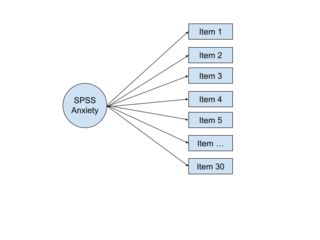This article includes a list of references, related reading or external links, but its sources remain unclear because it lacks inline citations .(November 2016) |
A belief structure is a distributed assessment with beliefs.
This article includes a list of references, related reading or external links, but its sources remain unclear because it lacks inline citations .(November 2016) |
A belief structure is a distributed assessment with beliefs.
A belief structure is used in the evidential reasoning (ER) approach for multiple-criteria decision analysis (MCDA) to represent the performance of an alternative option on a criterion.
In the ER approach, an MCDA problem is modelled by a belief decision matrix instead of a conventional decision matrix. The difference between the two is that, in the former, each element is a belief structure; in the latter, conversely, each element is a single value (either numerical or textual).
For example, the quality of a car engine may be assessed to be “excellent” with a high degree of belief (e.g. 0.6) due to its low fuel consumption, low vibration and high responsiveness. At the same time, the quality may be assessed to be only “good” with a lower degree of belief (e.g. 0.4 or less) because its quietness and starting can still be improved. Such an assessment can be modeled by a belief structure: Si(engine)={(excellent, 0.6), (good, 0.4)}, where Si stands for the assessment of engine on the ith criterion (quality). In the belief structure, “excellent” and “good” are assessment standards, whilst “0.6” and “0.4” are degrees of belief.
A Bayesian network is a probabilistic graphical model that represents a set of variables and their conditional dependencies via a directed acyclic graph (DAG). Bayesian networks are ideal for taking an event that occurred and predicting the likelihood that any one of several possible known causes was the contributing factor. For example, a Bayesian network could represent the probabilistic relationships between diseases and symptoms. Given symptoms, the network can be used to compute the probabilities of the presence of various diseases.
Factor analysis is a statistical method used to describe variability among observed, correlated variables in terms of a potentially lower number of unobserved variables called factors. For example, it is possible that variations in six observed variables mainly reflect the variations in two unobserved (underlying) variables. Factor analysis searches for such joint variations in response to unobserved latent variables. The observed variables are modelled as linear combinations of the potential factors plus "error" terms, hence factor analysis can be thought of as a special case of errors-in-variables models.
Critical thinking is the analysis of available facts, evidence, observations, and arguments to form a judgment. The subject is complex; several different definitions exist, which generally include the rational, skeptical, and unbiased analysis or evaluation of factual evidence. Critical thinking is self-directed, self-disciplined, self-monitored, and self-corrective thinking. It presupposes assent to rigorous standards of excellence and mindful command of their use. It entails effective communication and problem-solving abilities as well as a commitment to overcome native egocentrism and sociocentrism.

Multiple-criteria decision-making (MCDM) or multiple-criteria decision analysis (MCDA) is a sub-discipline of operations research that explicitly evaluates multiple conflicting criteria in decision making. Conflicting criteria are typical in evaluating options: cost or price is usually one of the main criteria, and some measure of quality is typically another criterion, easily in conflict with the cost. In purchasing a car, cost, comfort, safety, and fuel economy may be some of the main criteria we consider – it is unusual that the cheapest car is the most comfortable and the safest one. In portfolio management, managers are interested in getting high returns while simultaneously reducing risks; however, the stocks that have the potential of bringing high returns typically carry high risk of losing money. In a service industry, customer satisfaction and the cost of providing service are fundamental conflicting criteria.

Seismic analysis is a subset of structural analysis and is the calculation of the response of a building structure to earthquakes. It is part of the process of structural design, earthquake engineering or structural assessment and retrofit in regions where earthquakes are prevalent.

The Dunning–Kruger effect is a cognitive bias whereby people with low ability at a task overestimate their ability. Some researchers also include in their definition the opposite effect for high performers: their tendency to underestimate their skills. The Dunning–Kruger effect is usually measured by comparing self-assessment with objective performance. For example, the participants in a study may be asked to complete a quiz and then estimate how well they did. This subjective assessment is then compared with how well they actually did. This can happen either in relative or in absolute terms, i.e., in comparison with one's peer group as the percentage of peers outperformed or in comparison with objective standards as the number of questions answered correctly. The Dunning–Kruger effect appears in both cases but is more pronounced in relative terms: the bottom quartile of performers tend to see themselves as being part of the top two quartiles. The initial study was published by David Dunning and Justin Kruger in 1999. It focuses on logical reasoning, grammar, and social skills. Since then, various other studies have been conducted across a wide range of tasks. These include skills from fields such as business, politics, medicine, driving, aviation, spatial memory, exams in school, and literacy.
Evidential reason or evidential reasoning may refer to:

The following outline is provided as an overview of and topical guide to thought (thinking):
The rational planning model is a model of the planning process involving a number of rational actions or steps. Taylor (1998) outlines five steps, as follows:
In decision theory, the evidential reasoning approach (ER) is a generic evidence-based multi-criteria decision analysis (MCDA) approach for dealing with problems having both quantitative and qualitative criteria under various uncertainties including ignorance and randomness. It has been used to support various decision analysis, assessment and evaluation activities such as environmental impact assessment and organizational self-assessment based on a range of quality models.
A decision matrix is a list of values in rows and columns that allows an analyst to systematically identify, analyze, and rate the performance of relationships between sets of values and information. Elements of a decision matrix show decisions based on certain decision criteria. The matrix is useful for looking at large masses of decision factors and assessing each factor's relative significance.
Quality investing is an investment strategy based on a set of clearly defined fundamental criteria that seeks to identify companies with outstanding quality characteristics. The quality assessment is made based on soft and hard criteria. Quality investing supports best overall rather than best-in-class approach.

In multivariate statistics, exploratory factor analysis (EFA) is a statistical method used to uncover the underlying structure of a relatively large set of variables. EFA is a technique within factor analysis whose overarching goal is to identify the underlying relationships between measured variables. It is commonly used by researchers when developing a scale and serves to identify a set of latent constructs underlying a battery of measured variables. It should be used when the researcher has no a priori hypothesis about factors or patterns of measured variables. Measured variables are any one of several attributes of people that may be observed and measured. Examples of measured variables could be the physical height, weight, and pulse rate of a human being. Usually, researchers would have a large number of measured variables, which are assumed to be related to a smaller number of "unobserved" factors. Researchers must carefully consider the number of measured variables to include in the analysis. EFA procedures are more accurate when each factor is represented by multiple measured variables in the analysis.
Robust decision-making (RDM) is an iterative decision analytic framework that aims to help identify potential robust strategies, characterize the vulnerabilities of such strategies, and evaluate the tradeoffs among them. RDM focuses on informing decisions under conditions of what is called "deep uncertainty", that is, conditions where the parties to a decision do not know or do not agree on the system model(s) relating actions to consequences or the prior probability distributions for the key input parameters to those model(s).
The weighted product model (WPM) is a popular multi-criteria decision analysis (MCDA) / multi-criteria decision making (MCDM) method. It is similar to the weighted sum model (WSM). The main difference is that instead of addition in the main mathematical operation now there is multiplication.
The decision-making paradox is a phenomenon related to decision-making and the quest for determining reliable decision-making methods. It was first described by Triantaphyllou, and has been recognized in the related literature as a fundamental paradox in multi-criteria decision analysis (MCDA), multi-criteria decision making (MCDM) and decision analysis since then.
Intelligent Decision System (IDS) is a software package for multiple criteria decision analysis. It can handle hybrid types of uncertainty, including probability uncertainty, missing data, subjective judgements, interval data, and any combination of those types of uncertainty. It uses belief function for problem modelling and the Evidential Reasoning Approach for attribute aggregation. The outcomes of the analysis include not only ranking of alternative courses of action based on average scores, but also aggregated performance distribution of each alternative for supporting informed and transparent decision making.
Measuring attractiveness through a categorical-based evaluation technique (MACBETH) is a multiple-criteria decision analysis (MCDA) method that evaluates options against multiple criteria.
DEX is a qualitative multi-criteria decision analysis (MCDA) method for decision making and is implemented in DEXi software. This method was developed by a research team led by Bohanec, Bratko, and Rajkovič. The method supports decision makers in making complex decisions based on multiple, possibly conflicting, attributes. In DEX, all attributes are qualitative and can take values represented by words, such as “low” or “excellent”. Attributes are generally organized in a hierarchy. The evaluation of decision alternatives is carried out by utility functions, which are represented in the form of decision rules. All attributes are assumed to be discrete. Additionally, they can be preferentially ordered, so that a higher ordinal value represents a better preference.

Valerie Belton, commonly known as Val Belton, is a retired professor of management science at University of Strathclyde. She is a researcher who has worked on the design and application of multi-criteria decision making (MCDM) approaches for over 30 years. She co-authored a book on this field Multicriteria Decision Analysis: An Integrated Approach, that was released in 2002. She has attempted to incorporate multi-criteria decision analysis with problem structuring techniques, system dynamics, and other analytical approaches. She has a number of scholarly articles to her name and served as the editor of the journal Multi-Criteria Decision Analysis.